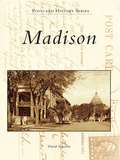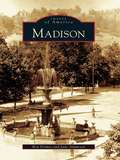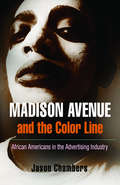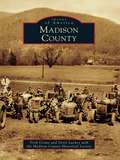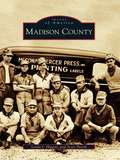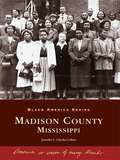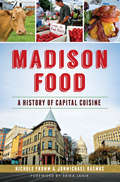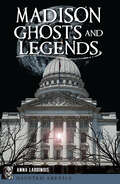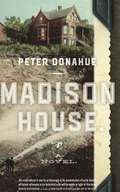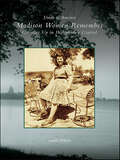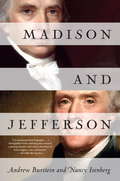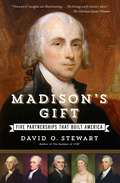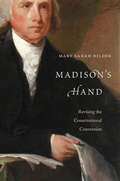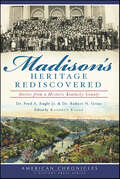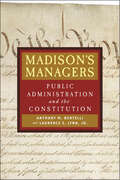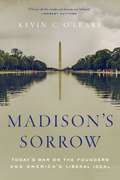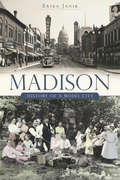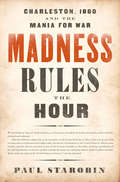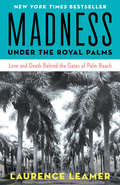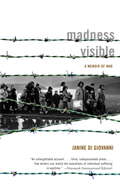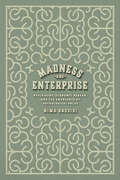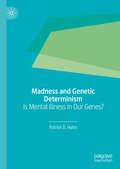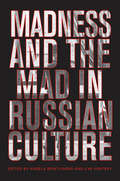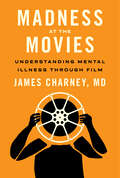- Table View
- List View
Madison
by David SakrisonMadison has a rich photographic history, much of it in the form of postcards. This volume presents more than 200 historical postcard images from the private collection of Madison resident John Powell, who has been collecting and trading postcards for more than 20 years. The images here reflect Madison's businesses, public institutions, civic life, and civic pride in the first decades of the 20th century. With author David Sakrison's engaging text, these images offer a unique window into the city as it was, and as it saw itself, 75 to 100 years ago.
Madison
by Jane Ammeson Ron GrimesMadison, tucked among the rolling southeastern hills that meander toward the Ohio River, was settled when Indiana was still a territory and became a city in 1809. A major river port, Madison thrived during the steamboat era as well as when railroads came to dominate the landscape. The city's glorious past is still on display. Many magnificent edifices dating back to eras from the beginning of the 1800s to the early 20th century provide wonderful examples of Federal, Greek Revival, and Italianate architecture. The National Register of Historic Places lists over 133 Madison blocks, making it Indiana's largest historic district. To stroll along the main streets of Madison, to follow the river as it meanders past the town, or to visit the restored railroad station, now home to the Jefferson County Historical Society, is to follow the paths of history. Very few cities in America can boast such centuries-old splendor.
Madison Avenue and the Color Line
by Jason ChambersUntil now, most works on the history of African Americans in advertising have focused on the depiction of blacks in advertisements. As the first comprehensive examination of African American participation in the industry, Madison Avenue and the Color Line breaks new ground by examining the history of black advertising employees and agency owners.For much of the twentieth century, even as advertisers chased African American consumer dollars, the doors to most advertising agencies were firmly closed to African American professionals. Over time, black participation in the industry resulted from the combined efforts of black media, civil rights groups, black consumers, government organizations, and black advertising and marketing professionals working outside white agencies. Blacks positioned themselves for jobs within the advertising industry, especially as experts on the black consumer market, and then used their status to alter stereotypical perceptions of black consumers. By doing so, they became part of the broader effort to build an African American professional and entrepreneurial class and to challenge the negative portrayals of blacks in American culture.Using an extensive review of advertising trade journals, government documents, and organizational papers, as well as personal interviews and the advertisements themselves, Jason Chambers weaves individual biographies together with broader events in U.S. history to tell how blacks struggled to bring equality to the advertising industry.
Madison County
by Madison County Historical Society Doris Lackey Trish CroweThis fertile and beautiful land, with its small rivers and valleys and surrounding mountains, was designated Madison County in 1792. The county was named for the family of James Madison, fourth president of the United States and the father of the Constitution. His family ran a mill on the Rapidan River, which is now located in the southern section of Madison County. Early in the 18th century, descendants of English and French colonials settled the southern sections of the county, and Quakers and German Lutherans settled the northern sections. Madison County's first church, Hebron Lutheran, was built in 1740, and its public church school was opened in 1748. Archaeologists have gathered evidence that Native Americans hunted and gathered in the region thousands of years earlier.
Madison County
by Linda J. Higgins Scott ParishMadison County became the hub of West Tennessee in the 20th century. Now major highways and rail lines traverse the county and its seat, Jackson. Three railroad companies and industry spawned by the railroads, such as the cotton mill town of Bemis, provided the main sources of employment during the 1900s. As job opportunities abounded, the population grew. Images of America: Madison County features the industrial development, business history, and lives of those people who were touched by this tremendous growth in Jackson and the county's outlying communities during the 20th century.
Madison County, Mississippi (Black America Series)
by Jennifer E. Cheeks-CollinsKnown as the "Land Between Two Rivers," Madison County is situated between the Pearl River to the east and the Big Black River to the west. It was created in 1828, and African slaves were among its earliest settlers. As the county grew, the African-American society began to create roots in this region, and their legacy continues to this day. Black America: Madison County explores a community marked by struggle, poverty, and segregation, a community that finally gained its voice during the Civil Rights Movement of the 1960s. This volume celebrates the lives of Madison County's black residents-past and present-and tells their story through vintage photographs.
Madison Food: A History of Capital Cuisine (American Palate)
by Erika Janik Nichole Fromm Jonmichael RasmusMadison's savory ascent as a culinary destination pairs its rich tradition of homegrown bounty with a progressively wider international palate. Sample the fare of Mad City staples like Ella's Deli, Mickies Dairy Bar and the Plaza and enjoy tales of legendary eateries of yore, such as Cleveland's, the Fess and Ovens of Brittany. Visit the farmers' markets that feed the capital city and the unions that have struggled to represent dishwashers and waiters. Slide into a booth with the visionaries who nurtured Madison's food culture, from Gulley to Guthrie and Peck to Piper. Food enthusiasts Nichole Fromm and JonMichael Rasmus share a taste of the unique ingredients spread across Madison's evolving table.
Madison Ghosts and Legends (Haunted America)
by Anna LardinoisWisconsin's capital city is haunted! From restless spirits roaming the University of Wisconsin to ghostly Confederate soldiers lingering at Camp Randall Stadium, Madison is filled with otherworldly entities. Spirits do not rest in peace at Taliesin, and the tragedies that occurred on the Capitol grounds shed light on the building's numerous paranormal reports. The city's outskirts are just as eerie. From the prowling Beast of Bray Road to what is thought to be Wisconsin's most haunted bar, a spinetingling location is never far away.Join author Anna Lardinois to discover some of Madison's most macabre tales.
Madison House: A Novel
by Peter DonahueMaddie Ingram, owner of Madison House, and her quirky and endearing boarders find their lives inextricably linked when the city decides to re-grade Denny Hill and the fate of Madison House hangs in the balance--Maddie's albino handyman and furtive love interest, a muckraking black journalist who owns and publishes the Seattle Sentry newspaper, and an aspiring stage actress forced into prostitution and morphine addiction while working in the city's corrupt vaudeville theater, all call Madison House home. <P><P>Had E.L. Doctorow and Charles Dickens met on the streets of Seattle, they couldn't have created a better book.
Madison Women Remember: Growing Up in Wisconsin's Capital (Voices of America)
by Sarah WhiteMadison is Wisconsin�s capital city and the �land of the four lakes.� Since the city�s founding 150 years ago, rich and poor have lived in close proximity surrounded by the beautiful lakes, a fact that has played a role in the city�s aspirations toward social justice and a good quality of life for all its residents. Celebrate Madison�s 150th birthday as women born between 1915 and 1957 reminisce about growing up here. Meet their families and friends, enjoy their pastimes, and ultimately follow them through their experience of an adventure everyone shares�coming of age at a particular place and time, receiving its stamp on one�s character, values, and ambitions. These moving, entertaining first-person accounts gleaned from oral history interviews with women from a wide range of backgrounds reveal the changing nature of Madison over time.
Madison and Jefferson
by Andrew Burstein Nancy Isenberg"[A] monumental dual biography . . . a distinguished work, combining deep research, a pleasing narrative style and an abundance of fresh insights, a rare combination."--The Dallas Morning News The third and fourth presidents have long been considered proper gentlemen, with Thomas Jefferson's genius overshadowing James Madison's judgment and common sense. But in this revelatory book about their crucial partnership, both are seen as men of their times, hardboiled operatives in a gritty world of primal politics where they struggled for supremacy for more than fifty years. With a thrilling and unprecedented account of early America as its backdrop, Madison and Jefferson reveals these founding fathers as privileged young men in a land marked by tribal identities rather than a united national personality. Esteemed historians Andrew Burstein and Nancy Isenberg capture Madison's hidden role--he acted in effect as a campaign manager--in Jefferson's career. In riveting detail, the authors chart the courses of two very different presidencies: Jefferson's driven by force of personality, Madison's sustained by a militancy that history has been reluctant to ascribe to him. Supported by a wealth of original sources--newspapers, letters, diaries, pamphlets--Madison and Jefferson is a watershed account of the most important political friendship in American history. "Enough colorful characters for a miniseries, loaded with backstabbing (and frontstabbing too)."--Newsday "An important, thoughtful, and gracefully written political history."--Publishers Weekly (starred review)
Madison's Gift: Five Partnerships That Built America
by David O. StewartHistorian David O. Stewart restores James Madison to his proper place as the most significant Founding Father and framer of the new nation: &“A fascinating look at how one unlikely figure managed to help guide…a precarious confederation of reluctant states to a self-governing republic that has prospered for more than two centuries&” (Richmond Times-Dispatch).Short, plain, balding, neither soldier nor orator, low on charisma and high on intelligence, James Madison cared more about achieving results than taking the credit. Forming key partnerships with Washington, Jefferson, Monroe, and his wife Dolley, Madison achieved his lifelong goal of a self-governing constitutional republic. It was Madison who led the drive for the Constitutional Convention and pressed for an effective new government as his patron George Washington lent the effort legitimacy; Madison who wrote the Federalist Papers with Alexander Hamilton to secure the Constitution’s ratification; Madison who joined Thomas Jefferson to found the nation’s first political party and move the nation toward broad democratic principles; Madison, with James Monroe, who guided the new nation through its first war in 1812, and who handed the reins of government to the last of the Founders. But it was his final partnership that allowed Madison to escape his natural shyness and reach the greatest heights. Dolley was the woman he married in middle age and who presided over both him and an enlivened White House. This partnership was a love story, a unique one that sustained Madison through his political rise, his presidency, and a fruitful retirement. In Madison’s Gift, David O. Stewart’s “insights are illuminating….He weaves vivid, sometimes poignant details throughout the grand sweep of historical events. He brings early history alive in a way that offers today’s readers perspective” (Christian Science Monitor).
Madison's Hand: Revising the Constitutional Convention
by Mary Sarah BilderJames Madison’s Notes on the 1787 Constitutional Convention have acquired nearly unquestioned authority as the description of the U.S. Constitution’s creation.<P><P> No document provides a more complete record of the deliberations in Philadelphia or depicts the Convention’s charismatic figures, crushing disappointments, and miraculous triumphs with such narrative force. But how reliable is this account?
Madison's Heritage Rediscovered: Stories From A Historic Kentucky County (American Chronicles)
by Dr. EngleFor over forty years, Dr. Fred A. Engle Jr. and Dr. Robert N. Grise have devoted themselves to researching and preserving Madison County�s history and cultural legacy through their weekly newspaper column, �Madison�s Heritage,� in the Richmond Register. Now, Kathryn Engle has sifted through the breadth of their impressive body of work, compiling a fascinating collection of historical tales from this remarkable Kentucky county. Beginning with stories of the hardscrabble pioneers who first settled the area and continuing with tales of Madison County�s local legends, important places and pivotal events, these diverse stories embody the essence of this historically rich area. Few know the heritage of this region as well as Engle and Grise. Journey back with them through the annals of Madison County�s history.
Madison's Managers: Public Administration and the Constitution (Johns Hopkins Studies in Governance and Public Management)
by Anthony M. Bertelli E. Jr. LynnA case for the constitutional roots of public administration: “Essential to the field as we develop new theories and applications in a postmodern America.” ?Political Studies ReviewCombining insights from traditional thought and practice and from contemporary political analysis, Madison’s Managers presents a constitutional theory of public administration in the United States. Anthony Michael Bertelli and Laurence E. Lynn Jr. contend that managerial responsibility in American government depends on official respect for the separation of powers and a commitment to judgment, balance, rationality, and accountability in managerial practice.The authors argue that public management—administration by unelected officials of public agencies and activities based on authority delegated to them by policymakers—derives from the principles of American constitutionalism, articulated most clearly by James Madison. Public management is, they argue, a constitutional institution necessary to successful governance under the separation of powers. To support their argument, Bertelli and Lynn combine two intellectual traditions often regarded as antagonistic: modern political economy, which regards public administration as controlled through bargaining among the separate powers and organized interests, and traditional public administration, which emphasizes the responsible implementation of policies established by legislatures and elected executives while respecting the procedural and substantive rights enforced by the courts. These literatures are mutually reinforcing, the authors argue, because both feature the role of constitutional principles in public management.Madison’s Managers challenges public management scholars and professionals to recognize that the legitimacy and future of public administration depend on its constitutional foundations and their specific implications for managerial practice.
Madison's Sorrow: Today's War on the Founders and America's Liberal Ideal
by Kevin O'LearyAn eye-opening cultural history of the political revolution that has destroyed the Republican Party and unleashed an illiberal crusade against the ideals of the Founding Fathers.The story of America is the struggle between our liberal ideal and illiberal resistance. Donald Trump catalyzed a reactionary revolution by tapping into the dark, shadowy side of American democracy that embraces exclusion and inequality. Throughout American history these alarming impulses have come to the forefront of our culture—during the Civil War, the era of the Robber Barons, and the Civil Rights Movement—but have now come to fruition in the presidency of Donald Trump. Arguing that the contemporary Republican Party is waging a counterrevolution against the core beliefs of the nation, journalist and scholar Kevin C. O&’Leary cracks open American history to reveal the essence of America&’s liberal heritage by critiquing the reactionary illiberal currents that periodically threaten American democracy. American politics is no longer an ongoing debate between liberals and conservatives because the new Republican Party embraces the feudal values of the Old World. While there are millions of conservatives in the population, the elected leadership of the GOP is deeply reactionary. Today&’s marriage of white-identity Southerners and their northern allies to moneyed libertarians is no run-of-the-mill political partnership. Instead, it is extraordinarily dangerous. Clearly, conservatives have lost their party. And without conservatives debating liberals in an intellectual, respectful manner to address the nation&’s problems, Madisonian democracy breaks down. A stimulating reinterpretation of the American experience, Madison&’s Sorrow exposes the intellectual and moral deficiencies of the illiberal right while offering a robust defense of the liberal tradition.
Madison: History of a Model City
by Erika JanikBeginning with the retreat of the Wisconsin glacier and the story of early Native American peoples, Janik narrates the journey of Wisconsin's capital city from the "center of the wilderness"? to the "Laboratory of Democracy."? Learn how Madison's citizens responded to the Civil War, industrialization and two world wars, as well as how advances in the rights of workers, women, Native Americans and African Americans made Madison the multifaceted city it is today. Comprehensive, accessible and swift, Madison: History of a Model City offers a fresh take on how Madison and its people came into being.
Madness Rules the Hour: Charleston, 1860 and the Mania for War
by Paul Starobin"The tea has been thrown overboard-the revolution of 1860 has been initiated." --Charleston Mercury, November 8, 1860In 1860, Charleston, South Carolina, embodied the combustible spirit of the South. No city was more fervently attached to slavery, and no city was seen by the North as a greater threat to the bonds barely holding together the Union. And so, with Abraham Lincoln's election looming, Charleston's leaders faced a climactic decision: they could submit to abolition--or they could drive South Carolina out of the Union and hope that the rest of the South would follow.In Madness Rules the Hour, Paul Starobin tells the story of how Charleston succumbed to a fever for war and charts the contagion's relentless progress and bizarre turns. In doing so, he examines the wily propagandists, the ambitious politicians, the gentlemen merchants and their wives and daughters, the compliant pastors, and the white workingmen who waged a violent and exuberant revolution in the name of slavery and Southern independence. They devoured the Mercury, the incendiary newspaper run by a fanatical father and son; made holy the deceased John C. Calhoun; and adopted "Le Marseillaise" as a rebellious anthem. Madness Rules the Hour is a portrait of a culture in crisis and an insightful investigation into the folly that fractured the Union and started the Civil War.
Madness Under the Royal Palms: Love and Death Behind the Gates of Palm Beach
by Laurence LeamerLove, lust, and fatal hatreds inside America's most exclusive enclave of wealth and privilege--Palm Beach.Bernard Madoff's Ponzi scheme devastated the eternally sunny world of Palm Beach, bringing down multimillionaires and destroying once-wealthy widows. The South Florida island and its rarified life suddenly found itself at the epicenter of the scandal, with this strange universe of wealth and privilege under an unrelenting spotlight.Now, in Madness Under the Royal Palms, Laurence Leamer shows us--as no one else has--this world of the megawealthy, which he calls "as hidden a place as I have ever resided." Digging deep, he hits a dark well of conflicting ambitions--right up to and including murder--much darker than the sky-blue weather and sunny Lily Pulitzer prints most of us associate with Palm Beach.
Madness Visible: A Memoir of War
by Janine Di GiovanniAward-winning journalist Janine di Giovanni spent much of the 1990s observing the cycles of violence and vengeance from inside Balkan cities and villages, refugee camps and makeshift hospitals. This was a conflict that raised challenging questions: what causes neighbours, whose families have lived peacefully for centuries, to turn with mindless brutality against one another? How do we measure the difference between bravery and cowardice in a conflict so morally ill-defined? What becomes of survivors when the fabric of an age-old community is destroyed? Searching for answers, di Giovanni brings the reality of war into focus: children dying from lack of medicine, women driven to despair and madness by their experiences in paramilitary rape camps and soldiers numbed by and inured to the atrocities they committed. In Madness Visible she paints an indelible portrait of the Balkans under siege and shows the true - human - cost of war.
Madness and Civilization: A History of Insanity in the Age of Reason (Routledge Classics)
by Michel FoucaultPerhaps the French philosopher's masterpiece, which is concerned with an extraordinary question: What does it mean to be mad?
Madness and Enterprise: Psychiatry, Economic Reason, and the Emergence of Pathological Value
by Nima BassiriUncovers a powerful relationship between pathology and money: beginning in the nineteenth century, the severity of mental illness was measured against a patient’s economic productivity. Madness and Enterprise reveals the economic norms embedded within psychiatric thinking about mental illness in the North Atlantic world. Over the course of the nineteenth century, various forms of madness were subjected to a style of psychiatric reasoning that was preoccupied with money. Psychiatrists across Western Europe and the United States attributed financial and even moral value to an array of pathological conditions, such that some mental disorders were seen as financial assets and others as economic liabilities. By turning to economic conduct and asking whether potential patients appeared capable of managing their financial affairs or even generating wealth, psychiatrists could often bypass diagnostic uncertainties about a person’s mental state. Through an exploration of the intertwined histories of psychiatry and economic thought, Nima Bassiri shows how this relationship transformed the very idea of value in the modern North Atlantic, as the most common forms of social valuation—moral value, medical value, and economic value—were rendered equivalent and interchangeable. If what was good and what was healthy were increasingly conflated with what was remunerative (and vice versa), then a conceptual space opened through which madness itself could be converted into an economic form and subsequently redeemed—and even revered.
Madness and Genetic Determinism: Is Mental Illness in Our Genes?
by Patrick D. HahnThe book covers important topics in the psychiatric genetics (PG) field. Many of these have been overlooked in mainstream accounts, and many contemporary PG researchers have omitted or whitewashed the eugenic and “racial hygiene” origins of the field. The author critically analyzes PG evidence in support of genetic claims which, given the lack of gene discoveries, are based mainly on the results of psychiatric twin and adoption studies. Given that the evidence in favor of genetic influences is much weaker than mainstream sources report, due to serious issues in twin and adoption research, the author points to environmental factors, including trauma, as the main causes of conditions such as schizophrenia.
Madness and the Mad in Russian Culture
by Ilya Vinitsky Angela BrintlingerThe problem of madness has preoccupied Russian thinkers since the beginning of Russia's troubled history and has been dealt with repeatedly in literature, art, film, and opera, as well as medical, political, and philosophical essays. Madness has been treated not only as a medical or psychological matter, but also as a metaphysical one, encompassing problems of suffering, imagination, history, sex, social and world order, evil, retribution, death, and the afterlife.Madness and the Mad in Russian Culture represents a joint effort by American, British, and Russian scholars - historians, literary scholars, sociologists, cultural theorists, and philosophers - to understand the rich history of madness in the political, literary, and cultural spheres of Russia. Editors Angela Brintlinger and Ilya Vinitsky have brought together essays that cover over 250 years and address a wide variety of ideas related to madness - from the involvement of state and social structures in questions of mental health, to the attitudes of major Russian authors and cultural figures towards insanity and how those attitudes both shape and are shaped by the history, culture, and politics of Russia.
Madness at the Movies: Understanding Mental Illness through Film
by James CharneyA unique exploration of how mental illness is portrayed in classic and contemporary films.The study of classic and contemporary films can provide a powerful avenue to understand the experience of mental illness. In Madness at the Movies, James Charney, MD, a practicing psychiatrist and long-time cinephile, examines films that delve deeply into characters' inner worlds, and he analyzes moments that help define their particular mental illness. Based on the highly popular course that Charney taught at Yale University and the American University of Rome, Madness at the Movies introduces readers to films that may be new to them and encourages them to view these films in an entirely new way. Through films such as Psycho, Taxi Driver, Through a Glass Darkly, Night of the Hunter, A Woman Under the Influence, Ordinary People, and As Good As It Gets, Charney covers an array of disorders, including psychosis, paranoia, psychopathy, depression, bipolar disorder, obsessive-compulsive disorder, and anxiety. He examines how these films work to convey the essence of each illness. He also looks at how each film reflects the understanding of mental illness at the time it was released as well as the culture that shaped that understanding.Charney explains how to observe the behaviors displayed by characters in the films, paying close attention to signs of mental illness. He demonstrates that learning to read a film can be as absorbing as watching one. By viewing these films through the lens of mental health, readers can hone their observational skills and learn to assess the accuracy of depictions of mental illness in popular media.
